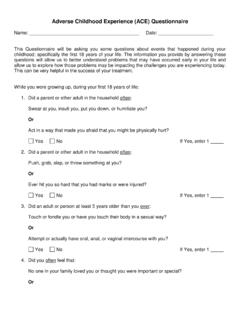Transcription of The Link between Types of Attachment and Childhood …
1 Universal Journal of Educational Research 4(5): 1071-1079, 2016 DOI: The link between Types of Attachment and Childhood Trauma Atilgan Erozkan Faculty of Education, Mugla S tk Kocman University, Turkey Copyright 2016 by authors, all rights reserved. Authors agree that this article remains permanently open access under the terms of the Creative Commons Attribution License International License Abstract The study investigated the relationship secure relationships, and the establishment of positive between Childhood trauma and Types of Attachment and the self-esteem. Crusto, Whitson, Walling, Feinn, Friedman, predictive role of Childhood trauma on Types of Attachment . Reynolds, Amer and Kaufman [4] found that caretaker The sample was composed of 911 (492 female; 419 male) support and healthy parent-child relationships reduce the risk university students at Mugla Sitki Kocman University, in of psychological problems in children after a trauma.
2 Turkey. Data were collected using the brief screening According to Howe [5] children who are subject to abuse are version of the Childhood Trauma Questionnaire and usually unable to find their caretaker available, or have Relationship Scales Questionnaire. Pearson product-moment caregivers whose behaviours lead to anxiety, fear, and anger. correlation analysis was employed to search for relationship Historically, caregivers' negligent, unpredictable, or between Childhood trauma and Types of Attachment ; unsafe behaviours may cause trauma in children and structural equation modeling was also used for explaining minimize the potential of the child with regards to dealing the predictive role of Childhood trauma on Types of with their longer-term traumatising effects, wherein the child Attachment . It was found that the physical, emotional, and lacks a convenient secure base to turn to for safety when sexual abuse, and physical and emotional neglect under threat.
3 Hence, along with developing strategic subdimensions of Childhood trauma were positively related solutions related to pronounced failures in caregiving, to fearful, preoccupied, and dismissing Attachment styles; finding ways of coping with traumatic experiences appears whereas these same variables were negatively related to the to be another necessity [6]. Children who have been subject secure Attachment style. Results were discussed in the light to trauma have certain imperfections in terms of of previous findings and in the context of Childhood trauma developmental domains, particularly in the sense of social and Attachment styles. Further replications using larger and emotional development [7] such as difficulty or inability samples should be conducted to explore the relationship to make and sustain friendships; being distant from or between Childhood trauma and Attachment styles. exhibiting oppositional behaviour towards parents, caregivers, and authorities and difficulties in developing Keywords Childhood Trauma, Attachment Styles, trust, intimacy, and affection.
4 These children are also likely University Students to lack certain emotions such as empathy, compassion, and remorse; and have a tendency of abusing substances and imitating the same maltreatment and Attachment disorder towards their own children when they become adults [8]. Children are particularly susceptible to exposure to 1. Introduction traumatic events during early Childhood as a critical period With regards to establishing healthy relationships with [9]. As a consequence of the traumatic events they have been others such as peers, partners, and their own children in later subjected to, children generally experience instabilities with life, early Attachment with caregivers plays a vital role [1]. regards to domains which constitute the emotional bases for Secure and healthy relationships between caregivers and development such as not trusting in caregivers, losing the children are likely to provide protection from negative expectation of being protected by other people, losing the effects of trauma experienced in Childhood .
5 A secure trust in social agencies, losing confidence towards social parental Attachment has been shown to help children justice or retribution and possessing feelings that they will effectively regulate emotional arousal [2]. Sroufe, Egeland, inevitably be victims in the future [10]. Due to trauma, most and Carlson [3] list the possible positive effects of healthy children will experience educational consequences, namely early Attachment with caretakers in later life as the capacity attention-related and learning disabilities, which would lead of emotional connectedness, the ability to build safe and to further complications in the child's profile [11]. In 1072 The link between Types of Attachment and Childhood Trauma addition, anxiety disorders, behavior disorders, and requirements in a consistent manner. This inconsistency substance abuse have all been linked to traumatic events steers individuals to consider themselves as unlovable and experienced during early Childhood [12].
6 As assessed urges them to believe that other people are capable to provide through measures of neglect and abuse, Childhood trauma support, whereas they do not always intend to. Since may negatively affect the functioning of individuals in their preoccupied individuals are never sure whether or not they adult lives, which may be observed through the relationships would get what they need, they either become attentive or established by these individuals with their families, friends, clingy when it comes to getting support from other people. and particularly partners [13, 14]. The Types and frequencies However, individuals with a fearful type of Attachment tend of traumatic experiences (physical, emotional, sexual abuse, to have had rejecting experiences with caregivers which and physical and emotional neglect) and whether they were leading to images of both self and others. Adults with fearful directly or indirectly experienced also can have various type of Attachment have desire for intimacy whereas they are negative effects on physical and mental health in adulthood afraid to be rejected.
7 Hence, they tend to alternate between [15]. approaching to and avoiding other people in order to get Primary causes of early Childhood vulnerability to trauma close to them[25]. include early loss or lack of consistent caregivers; emotional, Individuals having received unpredictable caregiving physical or sexual abuse and various forms of neglect. during their Childhood tend to use an ambiguous or Children with Attachment disorder tend to establish intimate preoccupied strategy. As adults, the inconsistent caregiving and sometimes overly devout or promiscuous relations with they experienced makes it hard for them to anticipate the new adults and constantly push away their primary caregiver possible responses of other people concerning their [7]. Interpersonal Childhood traumas (including physical requirements for safety and comfort. Since they have had abuse, emotional abuse, sexual abuse, physical neglect, and difficulties in anticipating the caregiving responses during emotional neglect) have been empirically related to various Childhood , those who use ambiguous or preoccupied strategy symptoms observed in adults -which have no somatic type are unable to depend on cognition to anticipate danger.
8 Explanation- such as chronic pain, headache, and Attachment Rather, they rely on their own affective arousal. As it would problems [16]. have been hard to settle and pacify these kinds of children Attachment based relationships are established in the early when distressed, the same counts for their adulthood when months and become gradually more complex and their Attachment system is alerted [26]. sophisticated while developing towards adult maturity. The Fonagy [27] emphasized that the most destructive factor in aforementioned relationships are developed based on the an Attachment relationship is trauma. Structuring of the brain child's requirement of to be protected from danger and the will be delayed in terms of the development process in case need for comfort under conditions of distress. Children where the parents fail to help their children cope with their depend on the type of response given by the caregivers to anxieties. Furthermore, in case where children experience these requirements [16].
9 The Attachment behavioral system frightening events with their parents [28], they are likely to presents children a clear survival advantage by maintaining a develop representations of them in their mind and develop balance between exploratory behavior and angry and frightening figures leading to constant pain and proximity-seeking behavior. Attachment needs remain bad feelings, instead of developing a safe environment in significant during the lifespan and Attachment behavioral their mind. They are also constantly alerted with regards to system is held to designate human beings from the cradle to the next response of the carers, or how to help them. the grave [17, 18], cited in [19]. Bowlby suggests that Affliction experienced by the babies when their relationships children develop mental models of themselves and of are disrupted affects their development process. relationships that impact their future relationships [20]. Unprocessed trauma disturbs mental functioning and affects Therefore, Bowlby's Attachment theory is the most elaborate the new relationships: children prefer relationships which model of the psychological mediators, according to later lead to new traumas [29].
10 Interpersonal functioning [18, 21, 22] cited in [23]. In any case, such behaviours conducted by the caregivers Bartholomew and Horowitz [24] developed a confront the children with a dilemma of how to safely classification system involving one secure and three insecure approach or avoid the person they are attached to. Although Types -dismissing, preoccupied, and fearful- of adult assumed as a collapse of strategy, disorganized Attachment Attachment ; those with a secure Attachment type generally appears to be related to more extreme traumas or neglect received a reliable caregiving in their Childhood , had a which brings together the characteristics of the avoidant and positive view of self and others and did not encounter any ambiguous strategies. These kinds of attachments are problems in depending on other people. On the other hand, thought to represent the collapse of Attachment strategies people with dismissing type of Attachment tend to have towards caregivers, where either of the parties is frightened received unresponsive caregiving; leading to consider [17].















